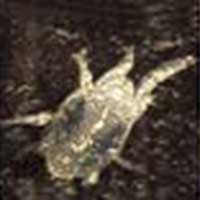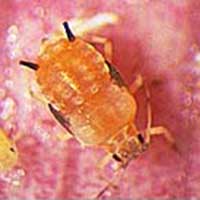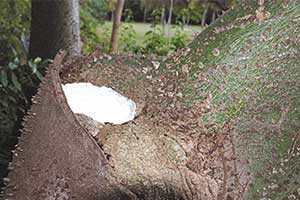
An IPM plan for the Control of Phtyophagous Mites on Musoid Plants

The Heliconia Society Bulletin, April 1991
The control of spider mites (Tetranychidae) on Musoid plants is challenging in any large collection of ornamental plants. The colonization of Musoid plants by spider mites normally begins on the oldest or senescent leaves. This observation by the author was made on Musa, Heliconia, and Calathea species at several plant collections in the South Florida area over a period of many years.
An Integrated Pest Management (IPM) program can be initiated to substantially reduce reliance on chemicals for the control of spider mites. This program is not only ecologically sound, but is also very cost-effective. Substantial savings are realized from reduced chemical purchases, and skilled labor that is freed from constant spraying can be utilized in other areas of the garden.
The onset of senescence (dying) - be it a single leaf, a branch, or the entire plant - brings about a breakdown of protein to soluble amino acids in the senescing tissue. This soluble nitrogen is translocated via the phloem to sites of storage (seeds) or new growth (Hill 1980). Many herbivorous insects are "flush feeders" that are adapted to feed on this nutritious sap contained in new growth (Auerbach and Strong 1981). Spider mites are "senescence feeders" that tap into this rich sap as it flows away from senescing tissue (White 1971).
Many different chemicals are used to control spider mites i.e.: Aldicarb (1), Dicofol (2), Oxamyl (3), Dienochlor (4), and Fluvalinate (5) [see footnotes]. These are all used with varying degrees of success on plants in the ground as well as on containerized plants. Pesticides are normally used on a rotational basis as chemical resistance becomes evident. During the course of a year certain groups of plants may be sprayed as many as eight times.
Pesticide use selects for pesticide resistance, and reduces the efficacy of biological control agents, such as predatory insects and fungi. This makes pest control increasingly difficult and costly. The use of chlorinated hydrocarbons, organophosphate pesticides, and fungicides has been shown to be followed by spectacular increases in the abundance of phytophagous mites on plants sprayed (McCoy 1977). An explanation for this phenomenon may be a reduction in biological control agents or a change in the physiology of the food plant due to a sudden increase in the concentration of available nitrogen in the tissues after the use of these chemicals (Bartlett 1968, White 1984).
Another factor that may cause an increase in mites is water stress. It has been suggested that drought is likely to increase the amount of readily available and assimilable nitrogen in the tissues of the food plant (White, 1974, 1984).
In spring 1988 the author implemented an IPM program for the control of spider mites on Musoid plants. This included provision of adequate water; plants were watered frequently as needed to prevent wilting. Lower leaves (leaves that would turn yellow in a few weeks) on all plants were removed on a regular basis. The objective in removing these leaves was to decrease the amount of available nitrogen to the spider mites.
After 2 years the program appears to be successful. The most any group of Musoid plants in the program has been sprayed is twice per year. Some have not required a single spraying. Removal of pre-senescent leaves does not appear to cause undue stress to the plants. Growth remains vigorous and flowering times seem consistent with pre-IPM times. Fruiting by Musa species is not affected and many plants appear to be more robust, although this is a subjective observation. All plants are fertilized on a regular basis and that schedule is not altered to supplement the loss of nitrogen due to leaf removal.
This IPM program for the control of spider mites on Musoid plants is entering its third year. Not only are hundreds of dollars in labor and chemical costs being saved, but an ecologically sound pest control program is being implemented.
Such an IPM program is ideal for zoological parks. Musoid plants and members of the Araceae are often not used in exhibits containing animals because of their susceptibility to spider mites. Chemical control of insect pests must be avoided around animals, especially ones as sensitive as birds. The removal of pre-senescent leaves of certain plant families may allow managers of animal exhibits to have more varied and exotic plant displays. This practice along with other IPM techniques should greatly assist horticulturists who are concerned about the excessive use of chemicals and their impact on the environment.
©1996 Jeff Shimonski
Director of Horticulture
Parrot Jungle and Gardens
References Cited: Auerbach, Michael J. and Donald R. Strong (1981) Nutritional ecology of Heliconia herbivores: Experiments with plant fertilization and alternative hosts. Ecological Monographs 51(1): 63-83.
Bartlett, B,R, (1968) Outbreaks of two-spotted spider mites and cotton aphids following pesticide treatment. 1. Pest stimulation vs. natural enemy destruction as the cause of outbreaks. J. Econ. Ent. 61: 297-303
Hill, J. (1980) The remobilization of nutrients from leaves. J. Plant Nutrit. 2: 407444.
McCoy, C.W. (1977) Resurgence of citrus rust mite populations following applications of methidathion. J. Econ. Ent. 70: 748-752.
White, T.C.R. (1971) Lerp insects (Homoptera, Psyllidae) on red gum (E. camaldulensis) in South Australia. South Aust. Nat. 46: 20-23.
White, T.C.R. (1974) A hypothesis to explain outbreaks of looper caterpillars, with special reference to populations of Selidosema suavis in a plantation of Pinus radiata in New Zealand. Oecologia (Berlin) 16: 279-301.
White, T.C.R. (1984) The abundance of invertebrate herbivores in relation to the availability of nitrogen in stressed food plants. Oecologia (Berlin) 63: 90-105.
FOOT NOTE: This article was published nine years ago. Since then the use of miticides at Parrot Jungle and Gardens has diminished even further. This same program of cutting off leaves on the Musoid plants before they senesce is still in place and still successful.




 About Integrated Pest Management
About Integrated Pest Management An Experiment in Arboriculture and Mosquito Control
An Experiment in Arboriculture and Mosquito Control German Cockroach Control through IPM
German Cockroach Control through IPM An IPM program for growing tropical plants using cultivation techniques
An IPM program for growing tropical plants using cultivation techniques Practical IPM for the South Florida Homeowner
Practical IPM for the South Florida Homeowner